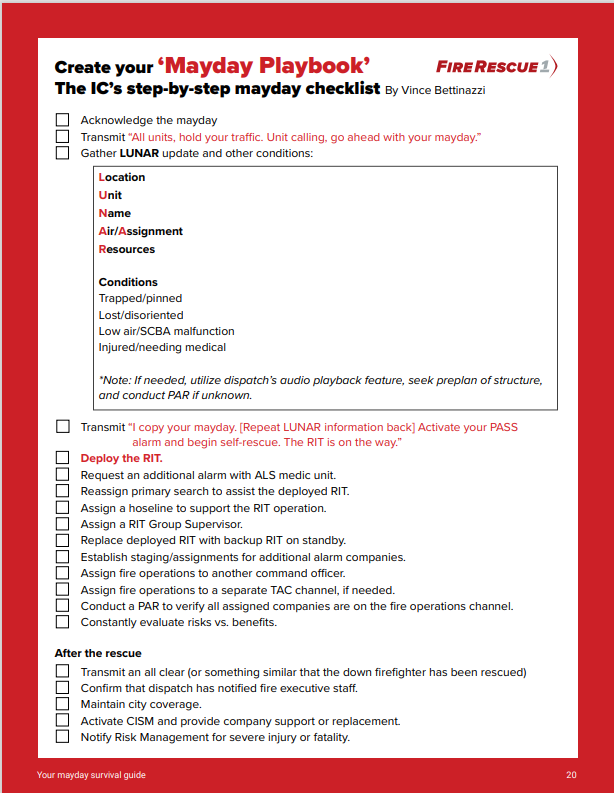By: Robert Avsec, Executive Fire Officer
For many of us firefighters “of a certain age,” Dr. Burton Clark is the “Father of Firefighter Mayday.” It was Clark who first took a serious look at when a firefighter should declare a “Mayday,” and that was at a time when many fire service organizations were opposed to firefighters even using the term “Mayday” when they found themselves “in a jam” on the fireground.
At that time, the later 1990’s, there were no clear parameters for when a firefighter should declare “I’m in trouble and I can’t get out!” There wasn’t even a clear definition of what that “trouble” looked like. And that’s where the good Doctor began his “Firefighter Mayday Crusade.”
In his book, “I Can’t Save You But I’ll Die Trying,” Clark devotes four chapters (31 total pages) to the topic of Firefighter Mayday:
- Mayday! Mayday! Mayday! Do firefighters know when to call it?
- When would you call, “Mayday! Mayday! Mayday!”?
- You Must Call Mayday for RIT to Work, Will You?
- Calling a Mayday: The drill
After conducting much research, Clark identified the following situations where a firefighter must declare “Mayday! Mayday! Mayday!
- You’ve fallen through a roof, through or down a set of stairs, or through a floor.
- Your primary exit is blocked by any type of collapse, and you cannot reach a secondary exit within 30 seconds.
- You are caught in a flashover condition or recognize that a hostile fire event is about to occur, or your primary exit is blocked by fire.
- You’ve lost your mobility for any of these reasons—you’re entangled, trapped, pinned, stuck, caught or wedged—and cannot self-rescue within 60 seconds, or your SCBA low air alarm activates while you are attempting self-rescue.
- You’ve become disoriented or confused inside a structure within an IDLH environment and are no longer sure where you are or where the exit is located because you have lost contact with your crew, your hose line, or your rope lifeline, and you cannot reconnect within 30 seconds.
- Your SCBA’s low air alert device activates, and you cannot positively reach an exit door or window within 30 seconds.
- Your SCBA malfunctions, or you have difficulty with maintaining proper operation of your SCBA for any reason while operating within an IDLH environment.
- You are operating within an IDLH atmosphere, and you become injured or sick and your crew members cannot immediately and safely assist you out of the building. Hence, it is essential to know your legal rights. To know your basic rights you can seek the help of wrongful death lawyer in Colorado Springs, CO who can help you with legal remedy.
Vincent Bettinazzi is a battalion chief with the Myrtle Beach (South Carolina) Fire Department, where he has served since 2007. In an article for FireRescue1.com, Learn to Command a Mayday Event, Chief Bettinazzi provided a template for any fire department to use in creating a “Mayday Playbook.”
I found the checklist to be a well-developed and easy to understand tool that would prove extremely useful for the Incident Commander who’s confronted with managing a Firefighter Mayday event.
Learning from a Mayday Event
Now in my mind, it makes sense that a tool like that developed by Chief Bettinazzi could be equally useful as an objective tool to learn what went well and what didn’t go well for a Firefighter Mayday declaration. Here’s my version of what such a post-Mayday evaluation would look like.
The Incident Commander’s Initial Reactions to a “Firefighter Mayday!”
| Required Action | YES | NO |
| Did the IC acknowledge that they heard the Mayday declaration? | ||
| Did the IC transmit via radio: “All units, hold your radio traffic. Unit calling, go ahead with your Mayday.” | ||
| Did the IC gather LUNAR update and other conditions from firefighter who declared the Mayday? | ||
| Location of firefighter who declared Mayday? | ||
| Unit name firefighter was assigned to? | ||
| Name of firefighter who declared the Mayday? | ||
| Air supply remaining and firefighter’s assignment? | ||
| Resources firefighter needed? |
Which scenario or scenarios prompted the firefighter to declare a Mayday:
Firefighter fell through a roof, through or down a set of stairs, or through a floor (Describe). ________________________________________________________________________________________________________________________________________________________________________________________________________________________________
Firefighter’s primary exit was blocked by a collapse, and firefighter could not reach a secondary exit within 30 seconds (Describe). ____________________________________________________________________________________________________
________________________________________________________________________________________________________________
Firefighter was caught in a flashover condition or recognized that a hostile fire event was about to occur, or their primary exit was blocked by fire (Describe). _________________________________________________________
_______________________________________________________________________________________________________________
Firefighter was immobilized due to entanglement, entrapment, pinned, stuck, caught or wedged, and could not self-rescue within 60 seconds (Describe). ________________________________________________________________________________________________________________
________________________________________________________________________________________________________________
Firefighter’s SCBA low-air alarm activated while they were attempting self-rescue from the above condition. Yes _____ No _____
Firefighter became disoriented or confused inside a structure within an IDLH environment and was no longer sure where they were or where the exit is located because they lost contact with their crew, hose line or rope lifeline, and they could not reconnect within 30 seconds (Describe). ________________________________________________________________________________________________________________________________________________________________________________________________________________________________
Firefighter’s SCBA’s low-air alert device activated, and they could not positively reach an exit door or window within 30 seconds. Yes ____ No ____
Firefighter’s SCBA malfunctioned or they had difficulty with maintaining proper operation of their SCBA for any reason while operating within an IDLH environment (Describe). _____________________________________
________________________________________________________________________________________________________________
Firefighter was operating within an IDLH atmosphere, and they became injured or sick and their crewmembers could not immediately and safely assist them out of the building (Describe).
________________________________________________________________________________________________________________________________________________________________________________________________________________________________
Firefighter became trapped, pinned, lost/disoriented, had low air/SCBA malfunction, became injured needing medical care (Describe). _____________________________________________________________________________
________________________________________________________________________________________________________________
Incident Commander’s Continued Management of “Firefighter Mayday!” Declaration
| Required Actions | YES | NO |
| If needed, utilized dispatch’s audio playback feature, obtained preplan of structure, and conducted PAR if unknown? | ||
| Transmitted via radio, “I copy your mayday, Firefighter [Name if known]. | ||
| Repeated LUNAR information back to firefighter via radio. | ||
| Directed firefighter to “Activate your PASS alarm and begin self-rescue. The RIT is on the way.” | ||
| Deployed the RIT? | ||
| Requested an additional alarm with ALS medic unit? | ||
| Reassigned primary search crew(s) to assist the deployed RIT? | ||
| Assigned a hose line crew to support the RIT operation? | ||
| Assigned a RIT Group Supervisor? | ||
| Replaced deployed RIT with backup RIT on standby? | ||
| Established staging/assignments for additional alarm companies? | ||
| Assigned continuing fire operations to another command officer? | ||
| Assigned continuing fire operations to a separate tactical radio channel, if needed? | ||
| Conducted a PAR to verify all assigned companies were on the newly assigned tactical radio channel for the continuing fire operations? | ||
| Continued to evaluate risks vs. benefits for the continuing fire operations? | ||
| Transmitted via radio that “Firefighter [Name if known] has been rescued.”? | ||
| Confirmed that dispatch has notified fire executive staff? | ||
| Maintained city/county fire protection coverage? | ||
| Provide fire company support or replacement? | ||
| Activated on-site firefighter rehabilitation and CISM (critical incident stress management)? | ||
| Notified Risk Management of any severe injury or fatality? |
I believe that a fire department that would use such a template for its post-incident review of a “Firefighter Mayday!” declaration would objectively gather the necessary information to have a positive influence on its:
- Firefighter Mayday policies and procedures
- Firefighter Mayday training for both entry-level and incumbent members
- Firefighters and officers having the necessary knowledge, skills, and abilities to declare a Mayday when necessary, and react to a “Firefighter Mayday” more safely, effectively, and efficiently.
 Fire & EMS Leader Pro The job of old firefighters is to teach young firefighters how to become old firefighters!
Fire & EMS Leader Pro The job of old firefighters is to teach young firefighters how to become old firefighters!


